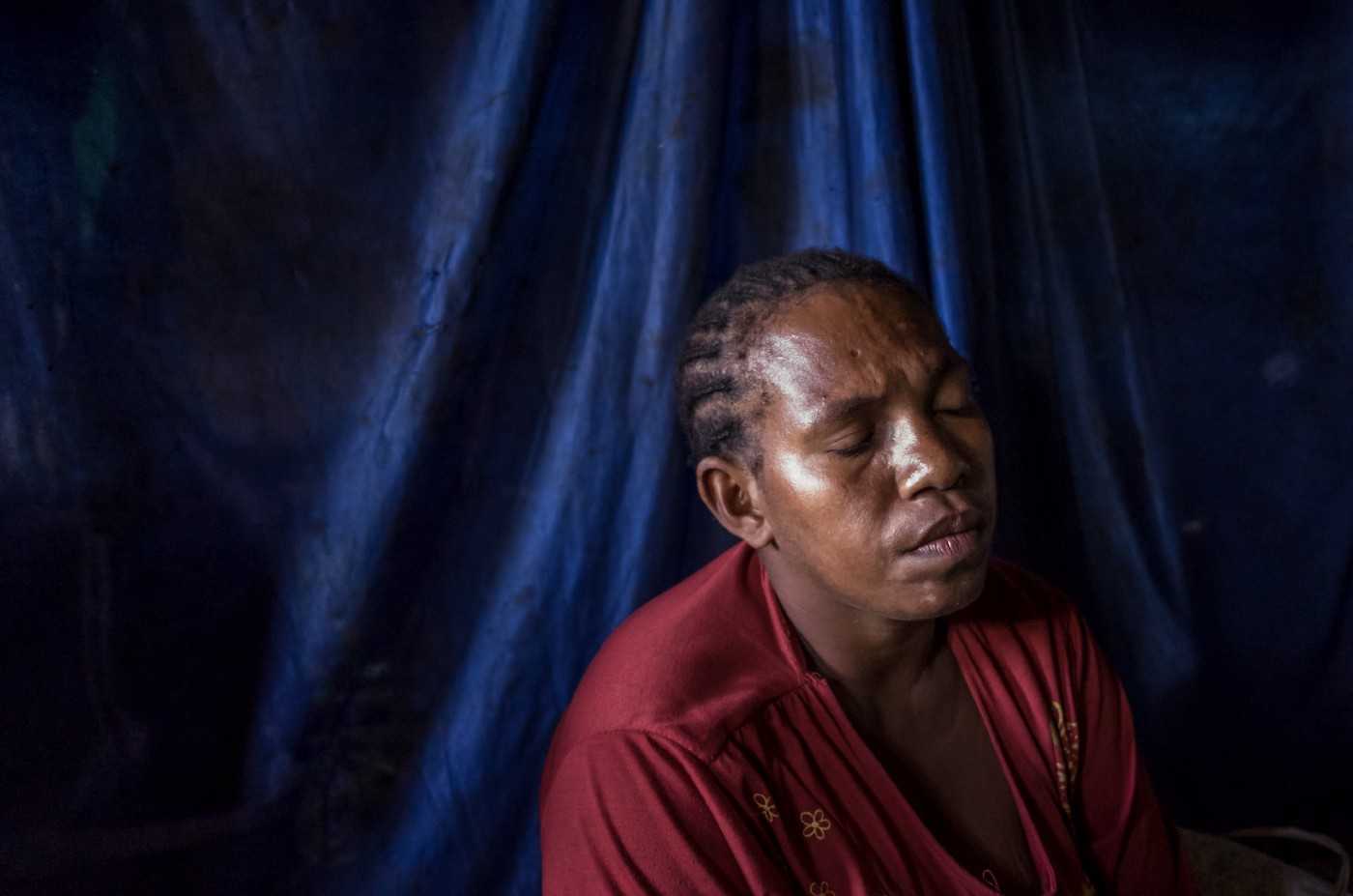A decade ago, the Indonesian government began to heavily promote large-scale plantation developments in southern Papua, a region of savannahs and rich rainforests.
An investigation recently published by The Gecko Project and Mongabay explored how some outside investors gained rights to land in this region and the fallout for the indigenous population. The investigation revealed that children were suffering from malnutrition while agricultural commodities are exported from their ancestral land.
Sophie Chao, an anthropologist at the University of Sydney, has spent years studying how such developments have affected the indigenous Marind people. In this op-ed, she explores how the loss of traditional foods that comes with deforestation, driven by plantation companies, has brought about both hunger and began to sever a deep cultural connection between the Marind and the natural world.
Photographs in this article feature people from clans in southern Merauke and were taken by Albertus Vembrianto.
This article was co-published with Mongabay.
In late May 2018, I was invited to dine at the home of Barnabus Ndiken, a clan head from the Upper Bian region of Merauke, a district in Indonesia’s easternmost province of Papua. The centrepiece of the meal, I had been told, was a dish of deer, caught by Barnabus and his kinsmen (pseudonyms have been used throughout this article). With vast swaths of forest being felled to make way for oil palm plantations, game in and around their village had become increasingly rare. Several of their children had never tasted it, and Barnabus himself had not eaten it for weeks. Meat was a special treat, served only to the most honoured guests. This portion had been saved especially for me.
When Evelina, Barnabus’s wife, began to grill the meat, a sickly sweet smell assailed my nostrils. Worried about the unpleasant odour, the women decided to boil the meat instead, but this only made things worse. The gelatinous chunks began to break apart, the broth turned milky, and the pungent steam rising from the pot stung our eyes. The meat, I realised, had been kept for too long and was rotten. Holding our breaths, my companions and I struggled to swallow the viscous pieces of grey flesh. Eventually, they lowered their heads and began to weep softly. First the women, then the men, and finally Barnabus. They told me they were weeping from shame.
Eventually, they lowered their heads and began to weep softly. They told me they were weeping from shame.
Beside me, Evelina was holding a bundle close to her chest, out of which poked what appeared to be firewood sticks. The bundle twitched. I thought I heard a faint whimper. Evelina removed the cloth, revealing an emaciated infant, whose frail bones jutted out of an almost translucent skin. The child’s eyes were expressionless, its face sallow, the fontanel — the soft spot in its head — sunken. The child’s name, Evelina told me, was Anna. It was her skeletal arms and legs that I had mistaken for branches.
Evelina tried to breastfeed the baby, but her flaccid breasts had no milk to give. Anna would not last the night. The village women and I stayed beside her until the break of dawn, when Anna drew her last breath.
Evelina rocked the small body. She told me that in the past, the Marind people had plenty of meat and sago. Their forest was full of food and they never went hungry.
“Now, oil palm eats our land,” I recall her saying. “Our skin is dry and grey, and our bodies are weak. Our children are small and frail. Many die before they have even learned to walk the forest. Now, Marind eat rice and instant noodles. Since oil palm arrived, everyone is hungry. This hunger never goes away.”
Read also: The Consultant: Why did a palm oil conglomerate pay $22m to an unnamed ‘expert’ in Papua?
Evelina and Barnabus are two of many indigenous Marind in rural Merauke who have lost their customary forests to agribusiness projects over the last decade. These developments, operated by South Korean and Singaporean conglomerates, are promoted by the Indonesian government in an effort to achieve national self-sufficiency in basic commodities. On the ground, however, agribusiness expansion is undermining the food and water security of Marind communities, who have traditionally relied on the forest for their subsistence.
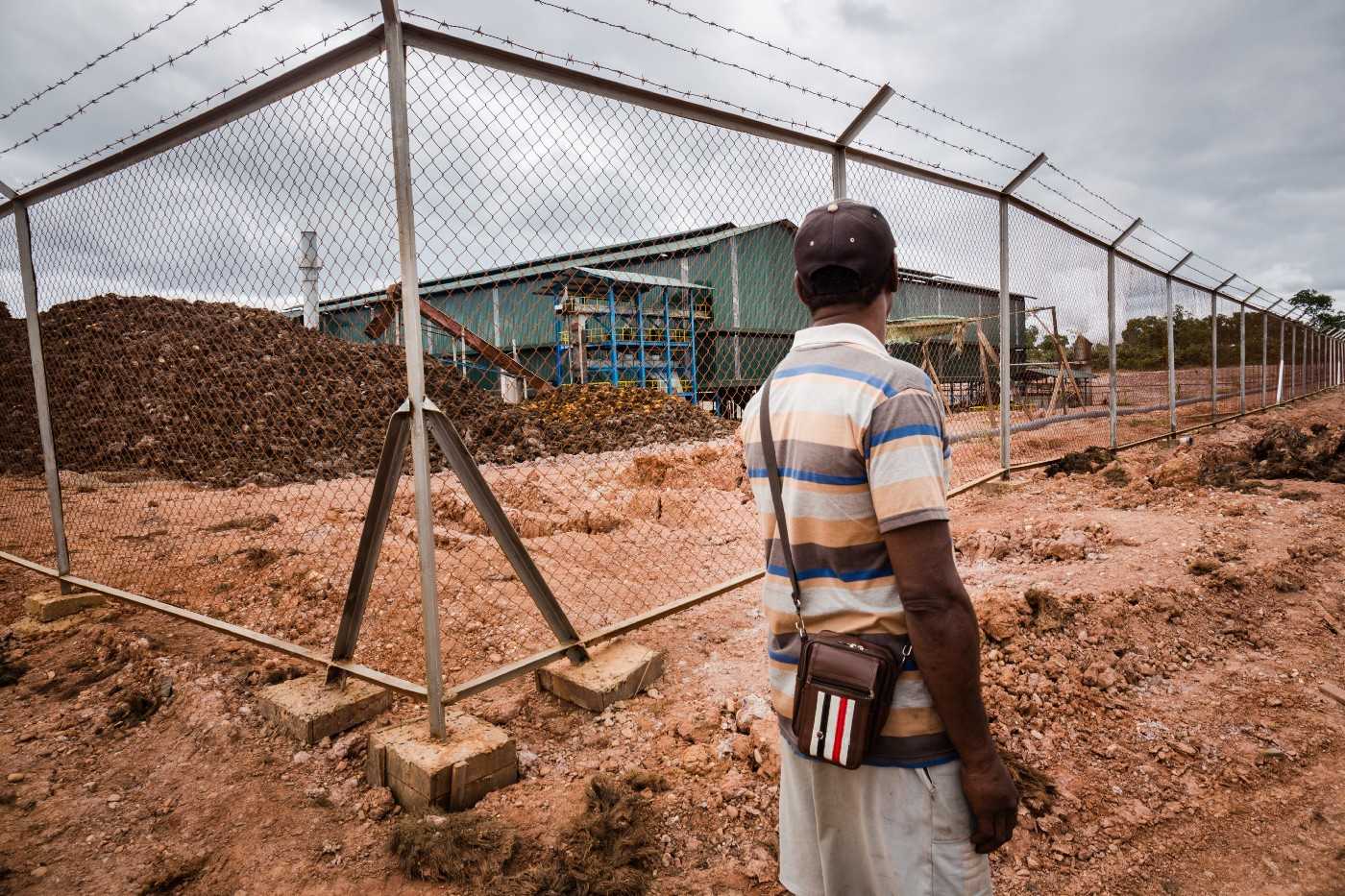
Once-plentiful game, such as cassowaries, kangaroos and wild pigs, have become difficult to encounter. Aquatic creatures, such as fish, crocodiles and crustaceans, have become contaminated with pesticides and palm oil mill effluents. Edible fruit, nuts and seed-bearing trees are increasingly rare.
I spent 18 months in the Upper Bian across four trips, between 2013 and the end of 2017, first as a human rights advocate and then as a doctoral candidate, researching the social and environmental impacts of deforestation and oil palm expansion among Marind communities. My fieldwork was undertaken in Marind villages as well as in the forest, carrying out interviews and participating in and observing their daily lives.
I found that many Marind associated the destruction of the forest and the arrival of monocrops with a pervasive and constant sensation of hunger. On the one hand, this hunger is visceral. Deforestation, water contamination and biodiversity loss have resulted in widespread hunger. Evelina’s baby, Anna, was one of many infants suffering from severe undernourishment in Kindiki village. With medical facilities only available in the distant township of Muting, several others had reportedly succumbed to malnutrition-related conditions over the preceding six months.

But the loss of forest foods also had a different dimension, a cultural hunger. As I learned from Marind during my time in the field, forest foods — vegetables, tubers, fruit, nuts, fish and game — are always “more than just food.” They derive from plants and animals with whom Marind share common descent from ancestral spirits, or dema. Marind have caring relationships with these species, which they consider to be “grandparent” or “sibling” species.
The relations of Marind to these non-human beings are based on mutual care and exchange. Plants and animals grow to support their human kin by providing them with food and other resources. In return, humans offer respect and perform rituals as they seek out and consume kindred plants and animals in the forest. Losing access to these foods, beyond the physical hunger, had a deeply adverse effect on Marind social and cultural well-being, severing these broad and deep connections to other species.
Marinds’ own bodies, too, are a part of the multispecies food chain of the forest. When people die, their flesh decays to feed organisms in the sacred groves where bodies are buried. Exchanges of flesh and fluids across species lines commemorate and sustain the relations of humans to non-human life forms within the cosmology of the forest. Marind are a part of this expansive, complex landscape. People and nature are not apart from one another, but rather intrinsically woven together. When this landscape — and all the species and food within it — is cleared, Marind cannot simply move on to working as labourers or buying noodles instead to satiate their hunger, because the whole world of which they are a part has been torn away from them. The food they eat, and how they obtain it, is a profound manifestation of that.
Of all forest foods, sago starch is considered by many Marind to be the most tasty, filling and nutritious. As in other Melanesian societies, the Marind word for sago, dakh, is also the generic term for “food.” “True Marind,” I was told repeatedly, are “Marind who eat sago.” Sago, then, is the most integral to the Marind sense of identity. It was just one part of a diverse range of other foods in the forest, such as game, legumes and tubers that, together, make for a balanced and nutritious meal. But it is sago, I was often told, that makes the body strong and fit. It allows men to hunt for days on end without feeling tired or hungry. It enables women to bear many healthy offspring. Children who eat sago develop tall and athletic bodies and learn to hunt and forage with ease.
Again, it is not just the substance of sago itself that Marind value, but how they procure it. Gathering and processing sago is a deeply social and collective activity, through which Marind affirm and enhance their relationships to each other and to the forest ecology. The labours involved in preparing sago starch — felling, rasping, leaching and cooking — are divided between men, women, and children, who all have a part to play in providing food for the community. Many Marind also derive great personal pride from procuring forest foods, and see it as a key part of the enculturation of their children into fully fledged members of Marind society.
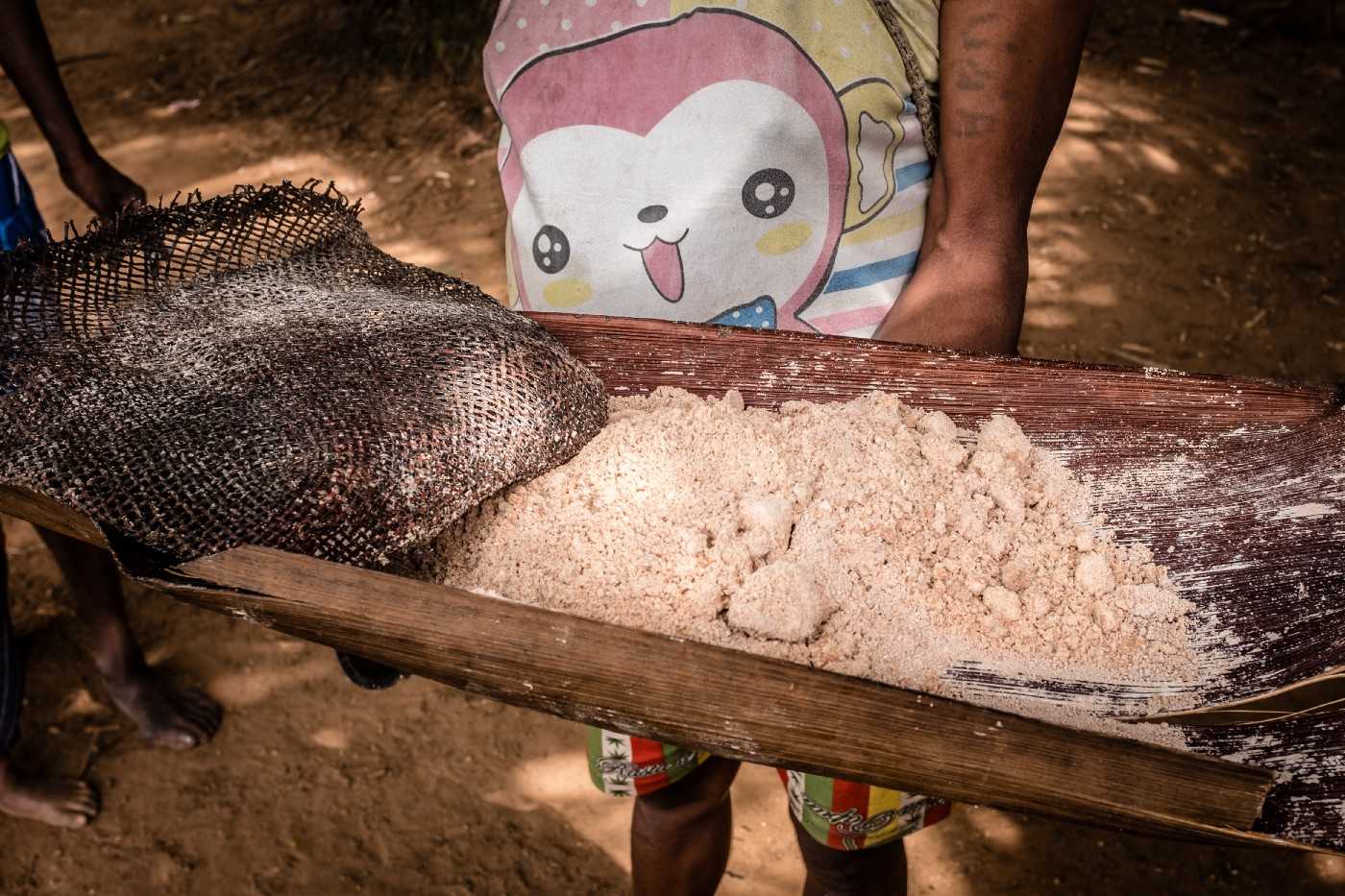
Children learn to enhance the environment of plants and animals in ways that support their growth and reproduction. They clear pathways for pigs and deer to travel to water catchments, leave fruit and nuts behind when foraging for cassowaries to feed on, and avoid disturbing the canopy during birds’ mating season. They also support the growth of sago itself through selective sucker transplanting and felling, clearing dying branches off the boles of sago palms, weeding their base and trunk, and judiciously pruning or trimming fronds to increase leaf formation and starch accumulation. These activities by Marind past and present are what sustain the growth of the forest, as well as the abundance of foods within it.
Going to the forest to procure food is also a way in which Marind connect with, and remember, past events, encounters, and figures of importance in Marind myth, whose stories are recounted by parents and elders to the younger generations. Eating sago and other forest foods produces a collective sense of identity among Marind. They often refer to themselves as “sago people,” affirming their shared connections with neighbouring Melanesian ethnic groups who also depend primarily on sago for their subsistence.
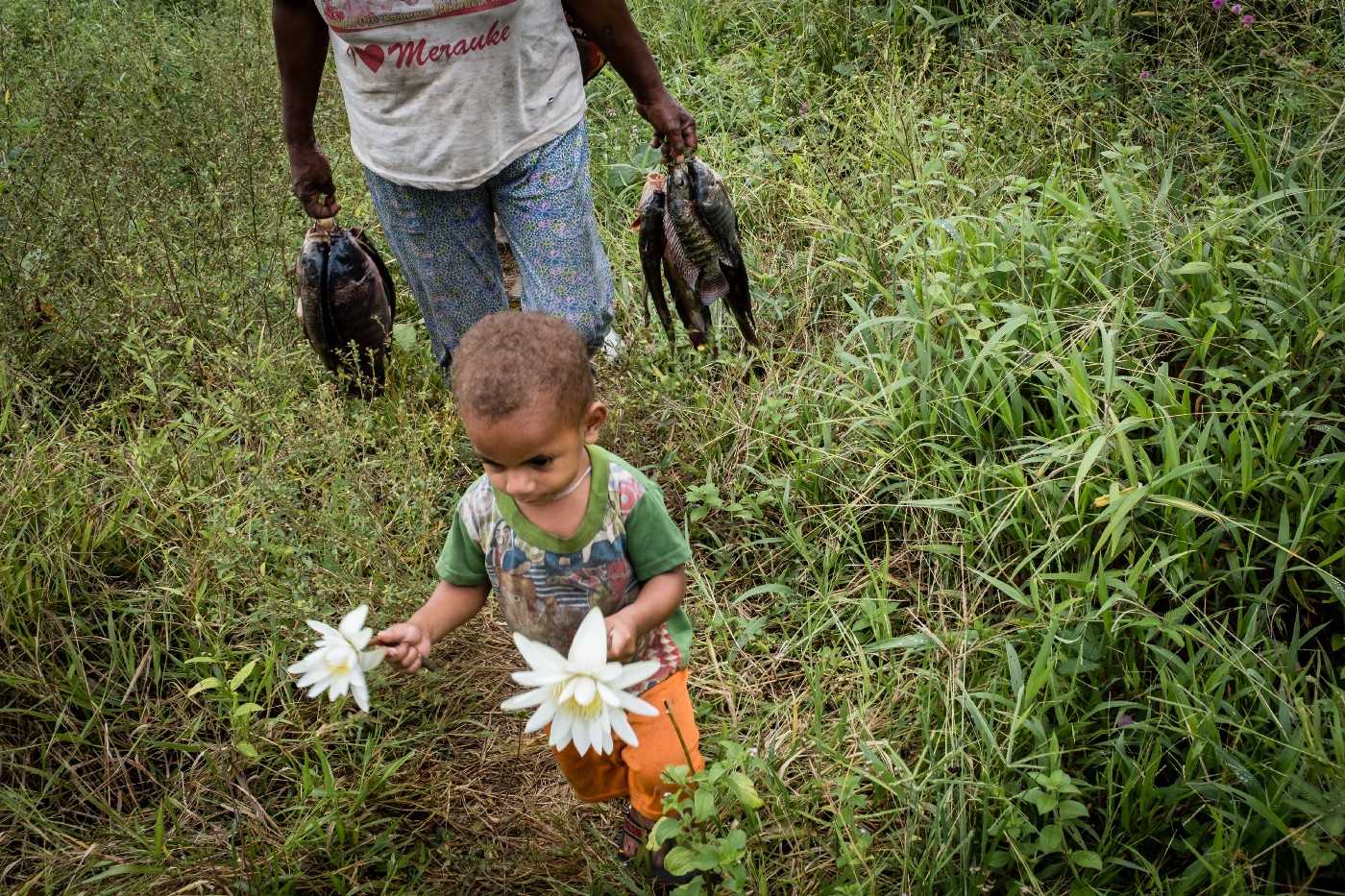
In contrast, imported commodities that are now increasingly replacing native foods are described by many Marind as tasteless and unsatiating because, as Rosalina, a Marind mother of three put it,
“they do not taste of the forest.” Foods like rice, instant noodles and biscuits come from unknown places and are grown and processed by unknown people. They are not derived from plants and animals with which Marind share intergenerational kinships and pasts. They are not procured or prepared by relatives or friends. They do not make people strong but rather weaken their bodies and constitution, in the Marind view. For all these reasons, processed foods are seen to lack the moral, cultural and emotional values that imbue forest foods with meaning and flavour.
Marind often point to their own deteriorating bodies as evidence of their hunger for forest foods. Rosalina spoke of her breasts becoming dry and her skin sallow from the absence of sago. Village men described how they had lost blood, fat and muscle for want of forest game. Many community members noted a loss of wetness in children whose bodies had become skinny and grey rather than glossy and taut. Experiencing hunger and witnessing the hunger of others also gave rise to feelings of sadness and anger, and in particular, a pervasive sense of loneliness arising from the severance of peoples’ connection to the forest and its kindred life forms.
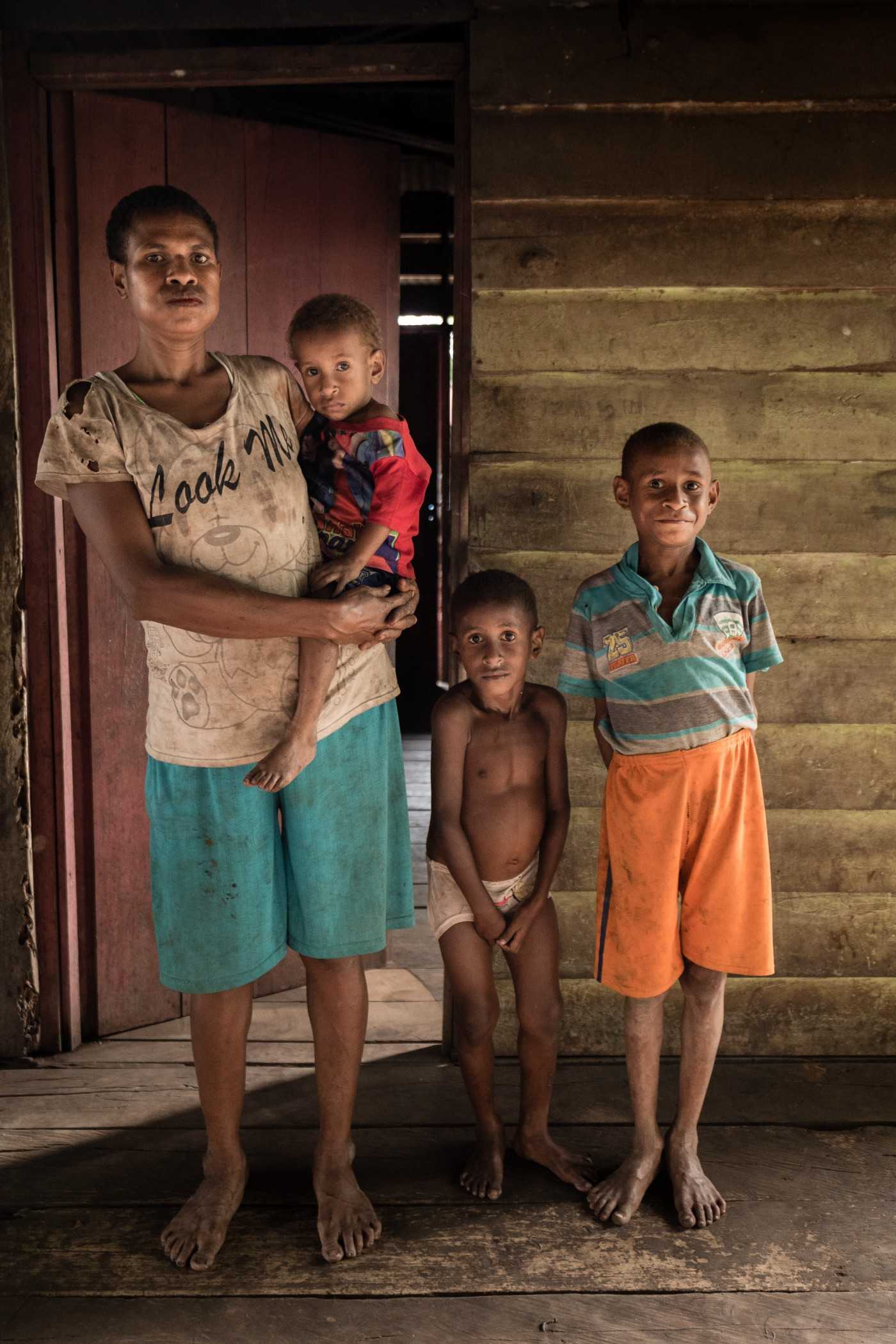
For instance, community members lamented the decline in collective hunting and foraging activities that had once sustained their ancestral relations to forest organisms. Women mourned the decimation of sago groves where they had once celebrated their role as mothers in the company of a plant whose fertile flesh and fluids, like their own, had provided for Marind children. Villagers who attempt to hunt and forage in the privatised concessions face the threat of interrogations, fines and expulsion by the soldiers who guard plantations. As village elder Gerfacius put it, “In the plantations, there is no freedom, no kin, and no real food. In the plantations, there is just hunger and loneliness.”
Many Marind also claim that processed foods don’t just fail to satiate their hunger, but actually exacerbate it. Children, for instance, clamour for more food within hours of eating instant noodles. Women described snacking on processed biscuits throughout the day but always craving more. Young men also talked of having become “addicted” to rice, which they would eat in copious amounts without feeling full. As Pius, a young man from Kindiki, described it, “When you eat sago, you can go without food for an entire day. But when you eat plastic foods, you become even more hungry. The more you eat, the more you want to eat. This hunger never goes away.”
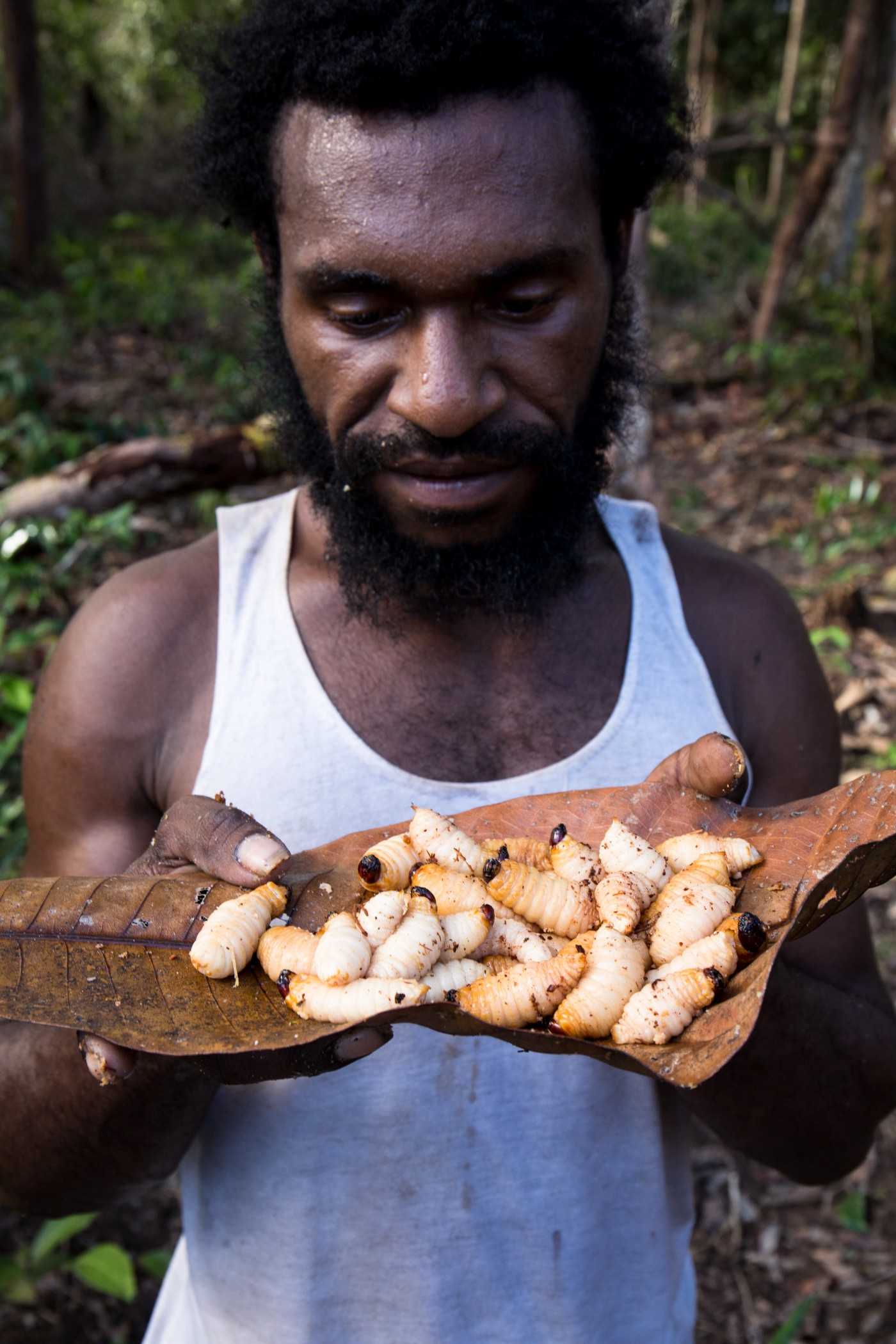
It is not just Marind who suffer from hunger as a result of deforestation. Robbed of their water, nutrients and symbiotes, plants and animals that once thrived in the company of their human kin, too, wilt and starve. Bamboo clusters and sago groves collapse as the soil is depleted of its minerals and the rivers contaminated by sludge. Pigs and cassowaries that venture into monocrop plantations die of starvation or are eaten or sold by migrants or company workers. Chemicals dumped into waterways contaminate the forest animals that drink from them, and corrode the flesh of the fish, turtles and crocodiles living within them. “Drunk” on toxins, they die and float to the surface.
Hunger, of course, is not an entirely new phenomenon among Marind. Many villagers recalled suffering from scarcity as a result of seasonal fluctuations and droughts. Extended periods of hunger, however, were rare and interpreted as punishments meted out by ancestral spirits against community members for failing to respect their non-human kin. Such violations included killing juvenile or gestating animals, felling or damaging sago palms and other vegetation, and failing to perform rituals when hunting and foraging. Remedy for the collective hunger inflicted by dema required the performance of pig sacrifices to the ancestors and ritual incantations and spells.
But the hunger Marind face today is different. It speaks to the loss of a forest ecology that is replete in nourishing foods and animated by plant and animal beings with which Marind share ancestral and intimate kinships. It speaks to the destruction of life on an unprecedented scale. In the past, hunger was a punishment inflicted by ancestral spirits upon Marind who failed to protect the forest and its life forms. Now, however, it is agribusiness companies that are wreaking havoc on the landscape, and Marind can do little to prevent this from happening.
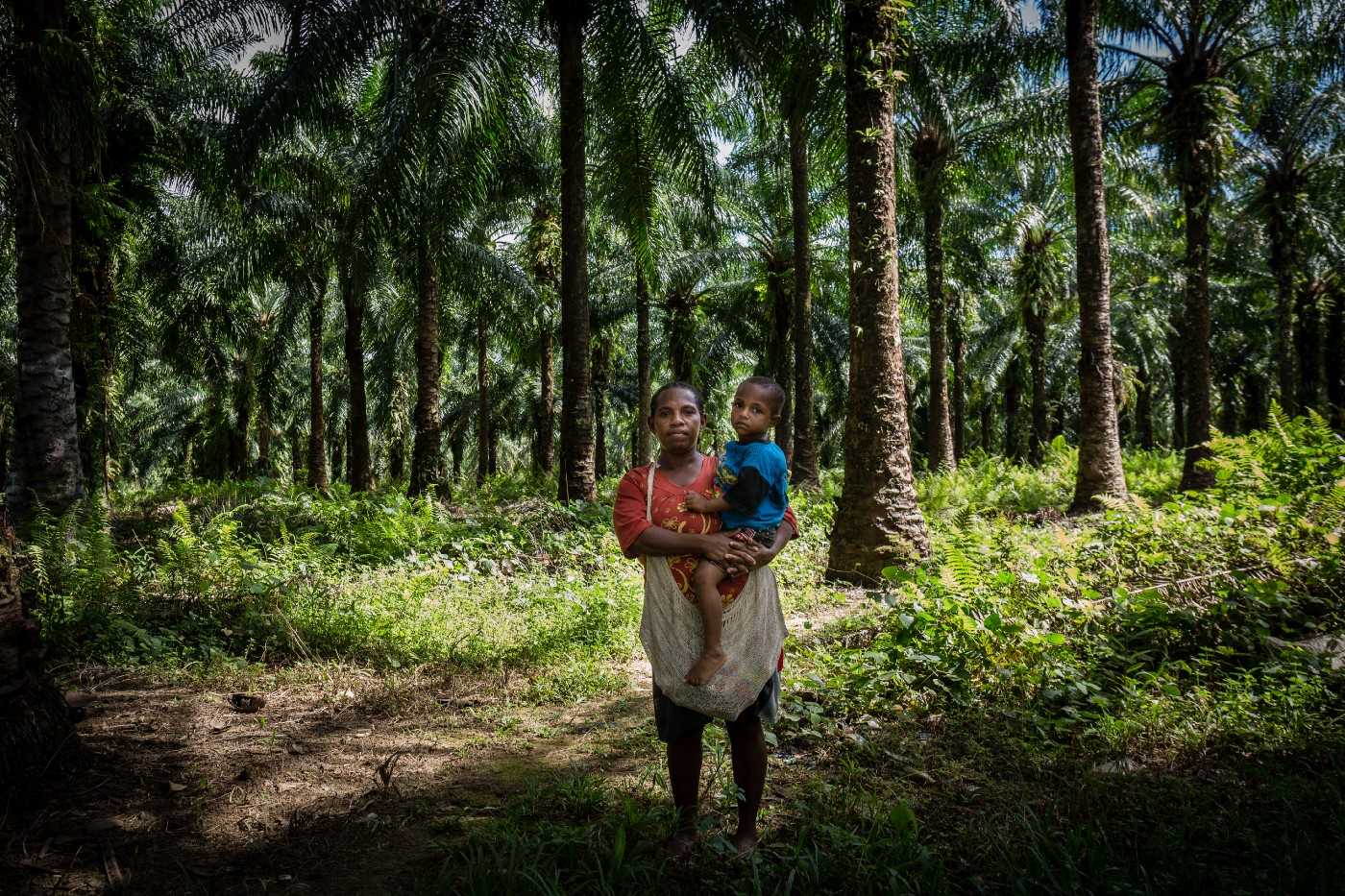
Hungers experienced by Marind today also speak to the loss of Marind food-based identities, social relations and ecologies as “sago people.” It gives rise to shame among parents, like Evelina and Barnabus, who are no longer able to feed their children. It brings into question the possibility of well-being — physical, cultural and emotional — of future Marind generations who may never know the forest and grow up on rice and instant noodles instead.
Many Marind also see hunger as symptomatic of a broader and longer pattern of discrimination toward the indigenous inhabitants of the Indonesian portion of New Guinea, collectively known as West Papua, on the part of the Indonesian state. Some, for instance, are aware of the irony at play when agribusiness projects implemented in the name of national food security give rise to local food insecurity. Others see this as evidence that indigenous West Papuans are disposable in the eyes of the state, and that only their land and natural resources matter.
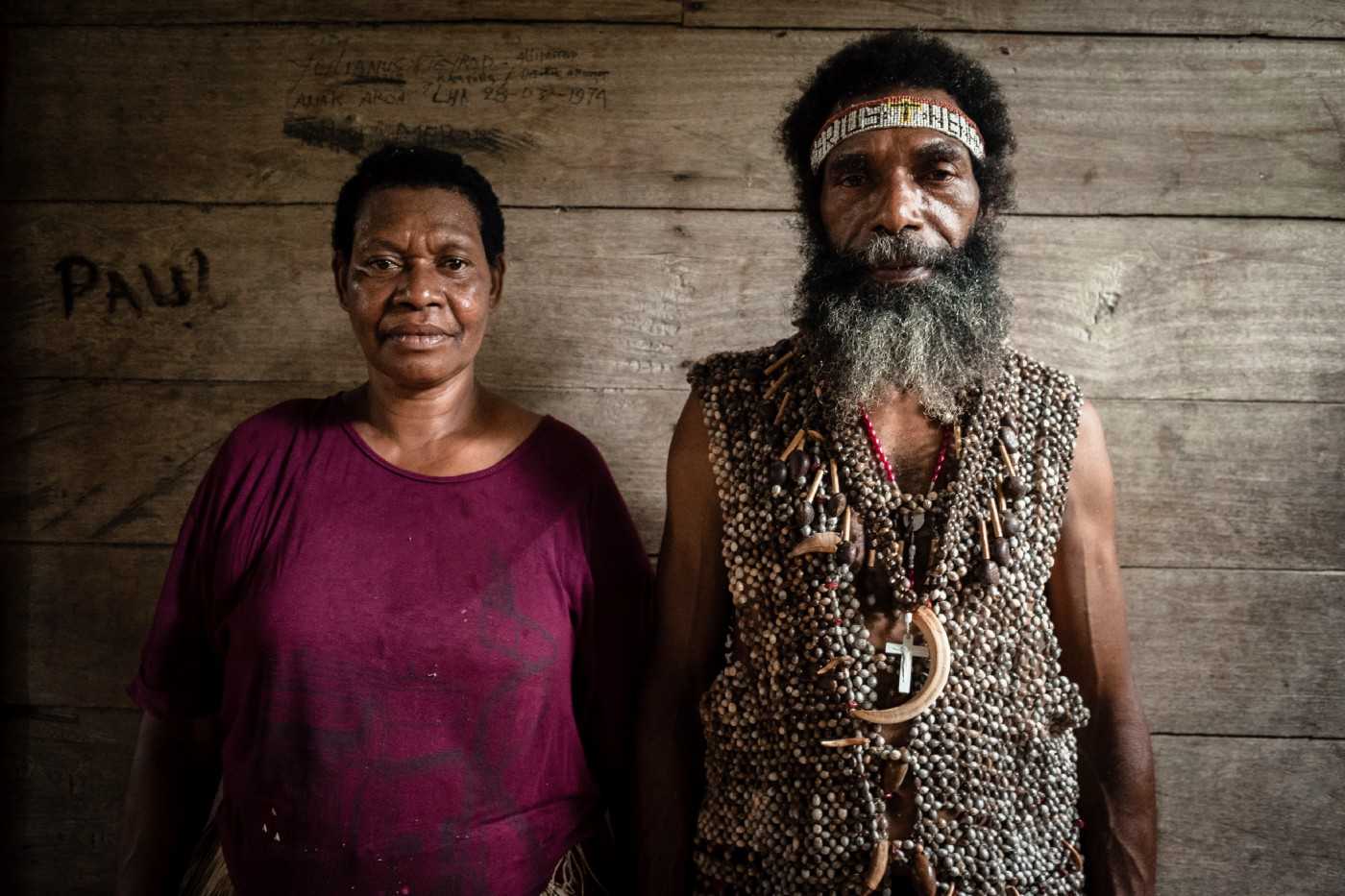
Many of my companions expressed anger and frustration over the patronising ways in which corporate and government representatives talk about Marind forest-based diet and way of life, which they often describe as primitive, backward and in need of development. This racialised rhetoric speaks in turn to the broader problem of “development” discourses in West Papua, that tend to be imposed by Indonesia without local consent or meaningful consultation, and yet putatively for West Papuans’ own good.
Marind experiences and perceptions of food insecurity reveal the deeply culturally shaped ways in which deforestation and agribusiness expansion impact upon indigenous well-being. The destruction of the forest deprives Marind of foods that are considered nourishing because of their association with kindred plants and animals, and with diverse human labours that shape Marind identity.
At the same time, the suffering wrought by hunger today speaks to a much deeper, and more disturbing, rupture in the everyday world of Marind. In the past, food scarcity was attributed to the wrongs and mistakes of Marind themselves, and particularly their failure to protect the forest environment. But now, the forest is being obliterated by powerful outsiders whose actions Marind have little power to control. This produces a seemingly inescapable double bind. Marind must sustain their customs and protect the forest to satisfy the ancestral spirits and sustain their forest food systems. Yet Marind are also vulnerable to the powers of corporations who destroy the very landscape from which these foods are derived. These two dimensions are irreconcilable. Together, they lead to a profound and ongoing erosion of Marind culture in the face of capitalistic forces, whose hunger for land and profit erodes the vulnerable beings and bodies dwelling upon and with it.
This article was produced with the support of the Money Trail Project (www.money-trail.org).
